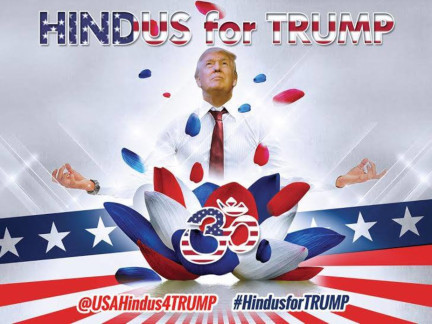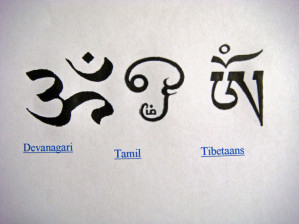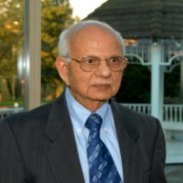Promod Puri's Blog: Hinduism:beyond rituals,customs and traditions, page 109
December 3, 2016
Polarization of Opinion
Our viewpoints are hard to change. We pick up from the internet and social media only that information and knowledge which support those viewpoints. And that consolidates our viewpoint. Moreover, “If you are exposed only to people with ideas that are like your own, it leads to political polarization: Liberals get even more extreme in their liberalism, and conservatives get more conservative”.Jennifer Stromer-Galley, Professor of Information Studies, Syracuse University


Nothing in The World Is Final
-Balraj Puri


Good thing about P.M. Trudeau
 The good thing about Prime Minister Justin Trudeau is that he is neither an extreme leftist nor an extreme rightist. Naturally he does not have, and rightly so, the “necessary nerve to take polarizing positions on heated issues”. For that reason perhaps, Trudeau approved the expansion of the pipeline that links Alberta’s oil sands to a tanker port in British Columbia.
The good thing about Prime Minister Justin Trudeau is that he is neither an extreme leftist nor an extreme rightist. Naturally he does not have, and rightly so, the “necessary nerve to take polarizing positions on heated issues”. For that reason perhaps, Trudeau approved the expansion of the pipeline that links Alberta’s oil sands to a tanker port in British Columbia.


November 27, 2016
THE CURSE OF INTERNET:
Our viewpoints are hard to change. We pick up from the internet and social media only that information and knowledge which support those viewpoints. The rest is considered propaganda material or just garbage.


WORLD DIVIDED BETWEEN TWO CASTES:
Politically the world is divided between two castes. The Leftists and the Rightists. As these are ideologically known and understood. And within these two castes are the sub-castes of Extreme Leftists and Extreme Rightists.
The people in the middle are politically a casteless society. They are the victims when RIghtists’ or Leftists’ agenda is delivered or enforced fanatically. With elements of power, ego and greed, opportunistically embraced by both, the Leftist and Rightist wingers in their varying colors and shades become fanatics. And this is what the Casteless society has to fight against for the rule of righteousness. promodpuri.com


November 25, 2016
Building Divine Residency More Relevant Than Knowing God He or She
By Promod Puri
If God or the Supreme Being is He, She or It; residing in heaven, up there in the sky or just omnipresent in the known or unknown universe. Do we need to indulge in this debate? Not really. Rather we create our own god based on noble thoughts, ethics, and good karma.
Besides His numinous and varied perceptions God also offers a meaningful perspective which can be created by the assembly of good thoughts. And the divine residency begins in that on-going construction.
Basically, it is an eloquent temperament we are trying to build which gives rationality and practicality to the institution of God.
The ecumenical concept of God of being the supreme governor who creates, sustains, and destroys the universe, and everything else including what influences our lives, does not reveal the reasons behind all the puzzles and mysteries of His or Her observable deeds.
In other words, our perception of God as being a creator with His mystical powers which sustains the universe, can not comprehend many universal and natural phenomenon.
One reason is that man is just one of the millions of creatures who is microscopic in His infinite and colossal universe. Still, our imaginations and metaphysical attempts know no boundaries to fathom His magnanimity. For a moment let us compare a human being to a small ant who is trying to study God up there in the celestial world.
But we don’t. Because this has been ingrained in our cognitive senses that man is the favored work of God as being the most intelligent among all His living creations. And that we are the only ones capable of studying His multi-dimensional but conceptual-based existence.
Perhaps, that little ant may be thinking the same. It may be believing humans walking tall up on the ground are the unintelligent creatures. Or we are the gods for the ant. Who knows!
Philosophers, saints, scientists, and even common man have all tried to study God and came up with varied perceptions and explanations. Imagination is very basic part of human psychology.
However, these discernments seldom explain what role God plays or His reasons of our happiness, sorrows, and everything else we come across in our day to day lives. We see, face or endure tragedies around us every day in this world of turmoil. And then ask God ‘why’.
While respecting some or most of the known realizations and imageries about Him, we take another view of God which we assemble by intelligent and ethical thoughts to helps us in explaining His involvements in the events we experience in our lives.
In this endeavor by mobilizing rational and moral thinking we are creating those karmas which can rationally explain the cause or causes of events personally experienced by us or happening around us where God may be involved or maybe not.
We are the major players to generate events and thus know the reasons for their results. Nevertheless, we can leave unexplained experiences as part of His mysterious ‘lila’ or play.
Instilling nobility or divinity in our thoughts is a continuous exercise of creating virtuous karmas. And that is where the grammar of God is involved both as a verb and as a noun merging into one entity.
It is a disciplined and conscientious undertaking to attain the practicality of God in our midst.
We are told, to be honest, humble, and sincere, be considerate and helpful to others, be merciful, forget and forgive, love fellow beings and care for the environments, including animals, plants, and nature. And everything else which is pious, pure, and morally firm to bring us closer to God realization.
While retaining the truism of these universal teachings we can contextualize them through our intellective senses to guide our day-to-day personal lives. This is where the blueprint of our construction begins to apprehend His pragmatics.
(Excerpts from Hinduism Beyond Rituals, Customs And Traditions)
progressivehindudialogue.com
promodpuri.com
promodpuri.blogspot.ca


November 24, 2016
MANUSMIRITI AND WOMEN
(From the book Hinduism Beyond Rituals, Customs And Traditions by Promod Puri)
Since bias knows no boundaries, Manusmriti not only expounds the social distance between the upper and lower castes, but it also delineates the status of women by curbing their rights. It lists guidelines for men in selecting marriage partners and puts a stamp of their superiority by creating gender inequality.
In chapter 3 with numbered paragraphs here it is what Manusmriti prescribes:
8. One should not marry women who have reddish hair, redundant parts of the body [such as six fingers], one who is often sick, one without hair or having excessive hair and one who has red eyes.
9. One should not marry women whose names are similar to constellations, trees, rivers, those from a low caste, mountains, birds, snakes, slaves or those whose names inspires terror.
10. Wise men should not marry women who do not have a brother and whose parents are not socially well known.
11. Wise men should marry only women who are free from bodily defects, with beautiful names, grace/gait like an elephant, moderate hair on the head and body, soft limbs and small teeth.
61. For if the wife is not radiant with beauty, she will not attract her husband; but if she has no attractions for him, no children will be born.
62. If the wife is radiant with beauty, the whole house is bright; but if she is destitute of beauty, all will appear dismal.
147. By a girl, by a young woman, or even by an aged one, nothing must be done independently, even in her own house.
148. In childhood a female must be subject to her father, in youth to her husband, when her lord is dead to her sons; a woman must never be independent.
149. She must not seek to separate herself from her father, husband, or sons; by leaving them she would make both (her own and her husband’s) families contemptible.
150. She must always be cheerful, clever in (the management of her) household affairs, careful in cleaning her utensils, and economical in expenditure.
151. Him to whom her father may give her, or her brother with the father’s permission, she shall obey as long as he lives, and when he is dead, she must not insult (his memory).
154. Though destitute of virtue, or seeking pleasure (elsewhere), or devoid of good qualities, (yet) a husband must be constantly worshiped as a god by a faithful wife.
155. No sacrifice, no vow, no fast must be performed by women apart (from their husbands); if a wife obeys her husband, she will for that (reason alone) be exalted in heaven.
156. A faithful wife, who desires to dwell (after death) with her husband, must never do anything that might displease him who took her hand, whether he be alive or dead.
160. A virtuous wife who after the death of her husband constantly remains chaste, reaches heaven, though she has no son, just like those chaste men.
161. But a woman who from a desire to have offspring violates her duty towards her (deceased) husband, brings on herself disgrace in this world and loses her place with her husband (in heaven).
And in Chapter 9 Manusmriti further explicates under each numbered paragraphs that:
3. Her father protects (her) in childhood, her husband protects (her) in youth, and her sons protect (her) in old age; a woman is never fit for independence.
10. No man can completely guard women by force, but they can be guarded by the employment of the (following) expedients:
11. Let the (husband) employ his (wife) in the collection and expenditure of his wealth, in keeping (everything) clean, in (the fulfillment of) religious duties, in the preparation of his food, and in looking after the household utensils.
29. She who, controlling her thoughts, speech, and acts, violates not her duty towards her lord, dwells with him (after death) in heaven, and in this world is called by the virtuous a faithful (wife, sadhvi).
30. But for disloyalty to her husband a wife is censured among men, and (in her next life) she is born in the womb of a jackal and tormented by diseases, the punishment of her sin.
In this dehumanized and demoralized portrait of the unequivocal surrender of a woman from childhood to death, restricting every step of her stage in life, one wonders if there are few soft spots of dignity, honor and some rewards for her sacrifices in the Manusmriti.
Yes, there are. Along with the prejudice against low caste Hindus and women, Manu has some cheering exhibits in the otherwise demeaning declarations in the Manusmriti.
In Chapter 3 with numbered paragraphs of Manusmriti his preachings and observation include:
55. Women must be honored and adorned by their fathers, brothers, husbands, and brothers-in-law, who desire (their own) welfare.
56. Where women are honored, there the gods are pleased; but where they are not honored, no sacred rite yields rewards.
57. Where the female relations live in grief, the family soon wholly perishes; but that family where they are not unhappy ever prospers.
58. The houses on which female relations, not being duly honored, pronounce a curse perish completely as if destroyed by magic.
59. Hence men, who seek (their own) welfare, should always honor women on holidays and festivals with (gifts of) ornaments, clothes, and (dainty) food.
60. In that family, where the husband is pleased with his wife and the wife with her husband, happiness will assuredly be lasting.
These silver linings in the Manusmriti provide a built-in support to decertify those defamatory statements which are not only illegal as per the constitution of India is concerned but morally, spiritually and ethically wrong.


November 22, 2016
What does Trump have to do with the Hindu sacred syllable, om?

Republican nominee Donald Trump was recently invited to a fundraising event organized by a conservative group of Hindu Americans, the Republican Hindu Coalition. A poster from the event, which describes the group as “Hindus for Trump,” portrays the candidate in a posture much like that of a yogi in deep meditation.
It shows Trump, face pointing upward and hands outstretched, rising up from a mass of red, white and blue flower petals in the shape of a lotus. Prominently displayed in the center is the Indian sacred syllable, “om,” decorated with stars and stripes.
Om is the preeminent Sanskrit mantra and symbol of Indian religions, especially Hinduism. In terms of religious identity, this sign denotes Hinduism in much the same way that the star of David and the Christian cross represent Judaism and Christianity. Om has its own dedicated sign in the scripts for Hindi and other Indian languages.
In global culture, the om sign has come to stand for Indian spirituality in general. It has been widely adopted by practitioners of yoga and meditation.
However, contemplation, transcendence or Indian spirituality would seem to have little in common with Trump’s public persona that has been described by the media as reflecting “narcissism, disagreeableness, grandiosity.”
So, what should we make of this juxtaposition of Trump and India’s “sacred syllable”?
For the uninitiated, here is what om means
The history of om stretches back more than 3,000 years. Om was first attested in the Vedas, a massive corpus of ancient “knowledge” (“veda” in Sanskrit) from the first millennium B.C. that furnishes the oldest and most authoritative texts of Hinduism.
The Upaniṣads, a collection of later Vedic texts regarded as the foundation for Indian philosophy, hailed om as “this whole world” and as the singular distillation of all wisdom.
Subsequent texts on Hindu law from the start of the Common Era codified the practice of intoning om at the start of every sacred recitation.
Hindu theological discourses emphasize that the sound of om is not of human origin – rather, it is a divine revelation and an audible expression of transcendence. By chanting or contemplating the mantra om, a practitioner gains access to a higher state of consciousness that leads to liberation from the cycle of rebirth.
In all these respects, the syllable has served as the quintessential symbol of religious authority in Hinduism – a role it continues to play up through the present day.
Multiple forms of om
 This history, however, is not that simple. My research into om’s early history reveals that this symbol, much like the Hindu traditions it has come to represent, is neither monolithic nor static.
This history, however, is not that simple. My research into om’s early history reveals that this symbol, much like the Hindu traditions it has come to represent, is neither monolithic nor static.
Om did not emerge suddenly as a full-fledged symbol of knowledge and the cosmos. Instead, premodern Hindu thinkers gradually constructed om as a single concept through contentious debates and theological reflections.
My research shows om in the Vedas does not have a single form or meaning. It is recited in many ways, appears in many different ritual contexts, and inspires a wide range of interpretations.
For example, Vedic experts in music described it as the sound of the sun, since it introduced their songs just like the sun signals the start of the day; the same singers called om “honey” for the sweetness it added to their melodies. Vedic specialists in sacrifice glossed om as an affirmation of ritual actions, as the “truth” inherent in their mantras. Other Vedic thinkers maintained that om was a secret password for attaining immortality at the moment of death.
Such examples could be multiplied many times over, not just in the Vedas but also in subsequent texts from Hindu, Buddhist and other Indian religious traditions where om is central to discussions about yoga, meditation, creation and salvation.
The bottom line is that India’s sacred syllable emerged over many centuries, depended on the contributions of different voices and accrued countless meanings along the way.
As a researcher of om, whenever I encounter the sign – whether inscribed in a manuscript, displayed at a Hindu temple or featured on a Donald Trump poster – its history of multiple meanings flashes into my mind.
There is no one Hindu voice
Now, against this background, let’s look at what the Hindus for Trump group is doing with its juxtaposition of Trump and om.
Hindus for Trump is closely allied with the Republican Hindu Coalition (RHC). Founded in 2015 by businessman Shalli Kumar, the RHC claims to provide “a single, unified platform for raising voice of Hindu Americans in public policy.”
In my view this raises the following issues:
Although in some contexts om is simply shorthand for “Hindu,” it seems problematic to harness this complex symbol to the single agenda of right-wing political activism among Hindu Americans.
Additionally, this raises another question: Do Hindu Americans really speak with only one voice?
Judging from the protests and the backlash on social media, there are many Hindu Americans besides Hindus for Trump and the RHC who might be inclined to associate Trump with syllables more profane than sacred.
Om’s history exemplifies the fact that Hindu traditions and Hindu identity are complex and varied. “Hinduism” covers an astonishing array of doctrines, practices and lifestyles in India, Asia and around the world.
While Hinduism’s history has not been free from conflict, there is an abiding openness to diversity at the roots of the tradition, as this famous verse from the Vedas attests (Rig Veda 1.164):
“Truth is one but the wise call it by many names.”
From a temple complex in suburban Boston to a street shrine in Varanasi; from Sanskrit dramas in Kerala to processions in Nepal – every day, practitioners, devotees and regular people create, contest and carry forward the traditions of this world religion in multiple ways.
The jarring juxtaposition of Trump and om reminds us that there is more to Hinduism and its iconography than a political poster can convey.
AUTHOR:
 Finnian M.M. Gerety Visiting Assistant Professor, Religious Studies, Brown University
Finnian M.M. Gerety Visiting Assistant Professor, Religious Studies, Brown University
Article courtesy The CONVERSATION.


TOLERANCE OR ACCEPTANCE
Jagessar Das M. D. President Kabir Association of Canada
People all over the world talk about tolerance, such as racial tolerance, religious tolerance or cultural tolerance, when they have to live in a society made up of people of different backgrounds. And this tolerance is often thought of as being a virtue. Let us try to understand what tolerance really means.
If you try to think clearly about what tolerance means, you will understand that it means to tolerate something or someone that is different, and with whom you cannot identify yourself. It means that you are not ready to accept that difference whether it is racial, religious or cultural. It means that you may “put up” with that difference. Thus, to tolerate something connotes a negative tendency, and it cannot be thought of as a virtue, if you tolerate another race, religion or culture. To tolerate something connotes an idea such as: “as far as I am concerned, it is all right if you cease to exist”, or “I hate you but I will tolerate you”, or “you are no good, but I will tolerate you”. So you tolerate something because you think that it is better to tolerate than to create enmity. It also could reflect the idea that to practice intolerance can get you into a great deal of trouble.
No society is entirely homogeneous, even if its members belong to the same race, religion or culture. Members of the same religion often divide themselves into different denominations, and often hold different cultural and religious values. Homogeneity in value systems is not a characteristic of any one society. Many people of the same society can express opposite ideas over any given situation. Thus to talk about tolerance, in terms of race, religion or culture, is not appropriate.
On the other hand, instead of tolerance, if people practice acceptance, then they will be pursuing a positive goal. To accept a different race, religion or culture is definitely a positive state, based on love, understanding, compassion, sharing and brotherhood. These values are taught in all the religions, and it is thus important for us to accept others, instead of merely tolerating them. To accept a different race, religion or culture obviously does not mean that you have to change anything except your attitude, biases and prejudices. In acceptance, we welcome the differences, because these are all the handiwork of God. People cannot do much about their race. Their culture differs because of their geographical location, history, religion, language, etc. Differences are a part of nature and God’s plan. If God wanted homogeneity, then all people would be exactly the same, as will all the flowers, and all the animals, and all the insects. It will then certainly be a very monotonous world. Such monotony, among people, can best be reflected by a whole population of robots, all looking alike, and doing the same thing. Such is not God’s plan, for in His wisdom, He has chosen to create the differences.
Certainly, there are things in society that we must not accept. Crime, violence of any type, hate, drug and alcohol abuse, stealing and cheating, are some things that we should not, as a society, accept. But the context in which I am discussing tolerance, deals with people in terms of race, religion and culture. And all religions and cultures are intolerant to the same type of evil deeds that bring suffering to individuals, and to society.
If we look at humanity, in general, we would see that we all must share the same earth and its resources. We all breathe the same air. We all need food, water, clothing and shelter. We all need the sunshine. Our bodies function in the same way, irrespective of racial differences. We all have the same basic needs. We are all destined to grow old and die. So while we have this precious gift of life, let us live nobly. Do not stain your life with prejudices or a sense of superiority! I remember a quotation stating that prejudice is a great time saver. It allows you to jump to conclusions without bothering with the facts.
When we look at life spiritually, then intolerance is due to ignorance. We have failed to see the reality that is manifesting in the hearts of all. Kabir said that the same Divine Light created all of us. Who then is superior and who is inferior? Again he said that he is in the marketplace of the world and wishes the welfare of all. He sees no one as friend or enemy.
For God there is no friend or enemy. Let us lift our spirit up to God and give up petty intolerances. Let us all, therefore, live according to God’s will in mutual acceptance, and in love and brotherhood.


Hinduism:beyond rituals,customs and traditions
...more
- Promod Puri's profile
- 1 follower





